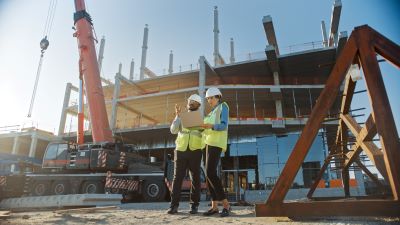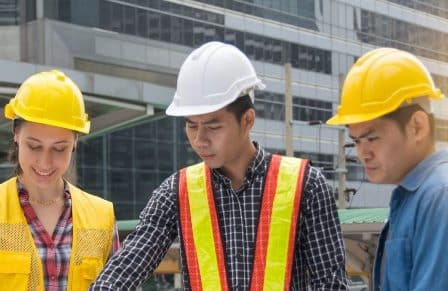Sustainable technologies in civil engineering, including green or sustainable concrete, become even more important now when population growth, continuous industrial development, and construction of infrastructure create huge amounts of construction and demolition (C&D) waste.
Additionally, fossil fuels are no longer the cornerstone of the built environment, as bio-based composite building materials are on an influx.
A combination of environmental factors, as well as newer regulations to meet environmental goals, have meant that engineers had to rethink materials used in the built environment – and there’s good evidence that sustainable concrete is here to stay.

Why change the way concrete is made?
Researchers have noted that the cement industry is responsible for significant environmental impacts. As much as 8% of global CO2 emissions are attributed to the cement Industry according to the United Nations.
Using by-products and plant materials in construction has been the subject of several discussions and current research. Traditionally, these materials are shown as alternative materials that represent a cleaner and more sustainable construction option and are economically advantageous.
In order to decarbonize concrete and make is sustainable, the main promising alternative is to replace Portland cement with lower carbon cementitious materials showing suitable properties.
Why cement CO2 emissions are so high
Essentially half of the emissions from cement are due to the process emissions arising from the chemical reactions associated with cement.
The chemical reaction in cement is the big culprit when the raw material is activated, but it is coupled with the fact that around 40% of cement emissions come from burning fossil fuels.
The burning is due to heat kilns and high temperatures are needed for the calcination process.
Another 10% of CO2 emissions from the cement industry come from simply mining and transporting the raw materials needed to make cement.
Cement, as we know it, is merely a mix of sand, gravel, water, and binder cement. The binder is the problem when it comes to environmental management since it’s made by the calcination of lime and clay as well as additional components. Together these form stable calcium silicate hydrates during the hardening of the cement.
The calcination of lime is the process that drives CO2 emissions so high because for every molecule of calcium oxide produced, the burnt lime or quicklime releases one molecule of greenhouse gas carbon dioxide.
For the estimated annual world production of 4.5 billion tons of cement, 2.7 billion tons of carbon dioxide are released.

How Green, or Sustainable, Concrete changes that
To start, the concept of Green Concrete needs to change the activation process, and that doesn’t mean it should consist of potato peels or discarded waste (although that would also be ideal).
Johannes Gutenberg University Mainz (JGU) in Germany developed a new method to reduce CO2 emissions. In the process developed by the university, raw lime (CaCO3) is not converted to burnt lime in coal-fired kilns. Instead, it is simply milled with solid sodium silicate (Na2SiO3).
This step produces an intermediate activation that contains the constituents of the cement in an equal distribution.
When reacted with sodium hydroxide solution, what is formed is structurally very similar to calcium silicate hydrates.
The milling step is carried out at room temperature and as a result, bypassing lime calcination could avoid CO2 emissions in the gigaton.
But limestone also still forms part of some solutions in concrete.
Limestone calcined clay cement is a new blend of two materials that have a synergetic effect.
It can reduce emissions by up to 40% and is made using limestone and low-grade clays. These clays are abundantly available and could cut down emissions due to transport. It is also cost-effective and does not require expensive modifications to existing cement plants. It also uses industrial waste materials which can increase resource efficiency and cut the reliance on scarce raw materials.
This application has been especially suited for prestressed and post-tensioned concrete that is used in masonry mortars and plastering, used in decorative and art structures and also concrete to use in the manufacture of precast sewage pipes.
Non-carbonized agricultural waste is another solution. Agricultural waste is a global problem, so its incorporation into concrete reduces both the energy consumption for its normal utilization and during the preparation of concrete.
Natural, organic fibers and particles can provide offers advantages because of the lower costs and omission of energy consumption during pyrolysis.
Dry biomass contains different fibers that may work as a reinforcement of cement.
This is a ‘green’ contrast to the classical reinforcement cement that uses natural minerals and reinforcement with steel or other synthetic materials.
Engineers have also noted that plant-based additives can improve the characteristics of mortar, with positive changes to its hydration rate, elasticity, volumetric changes and porosity.
According to Tam, Soomro and Evangelista, depending on their quality, recycled aggregate produced from C&D waste can be employed in various civil engineering works, which can help in a long way the economic and environmental sustainability of respective countries.
To enhance the production of green concrete is important to focus on further research and development into overcoming technical as well as market barriers, considerable increase in recovery rates can be achieved with the existing technologies in developed economies.
Practical examples from Australia
In 2019 Australia staged the first road project using green concrete that used reprocessed industrial waste from power stations and the steel manufacturing industry.
The paper Installation of Geopolymer Concrete Pavement at Wyndham Street for the City of Sydney: Interim Report paints a positive picture of how reprocessed waste has major benefits.
Wyndham Street, a busy section of Sydney was selected as a trail to show a zero emissions stretch of road is plausible in the city and can be constructed quickly.

The development and use of inorganic polymer binders like geopolymer that uses alkaline activated binders offer benefits in reducing the emissions associated with conventional concrete
Two trucks with 10m3 of concrete were poured during the project.
This then was leveled and the usual cement processes were followed. After the pouring and leveling a curing compound was sprayed. The cement then had to dry.
After the process, the concrete was tested for strength, and this too was successful. But engineers noted that the cement is “sticky”. GPC can be “sticky”.
This made the cement difficult in terms of handling and levelling the road. Another note mentions the surface hardens fast, but when faced with new vibration it can become liquefied again (much like soils.).
The paper concludes geopolymer concrete pavements had good strength as time lapsed and estimated strength of 22 MPa when the road reopened, 36 hours after the last concrete was poured.
This project showcased the potential for green construction materials in Sydney and the adoption of Geopolymer concrete as standard practice for cement-based pavements.
One of Australia’s major developments in the green/sustainable concrete frontier is the Green Cement Transformation Project.
The Hallett Group-backed project is estimated to be the largest carbon reduction innovation project in Australian history. Hallett Group aims to construct a sovereign manufacturing capability aimed to process and distribute three streams of Australian-generated industrial waste by-products into low-carbon green cement products.
The project will reduce Australian CO2 emissions by 300,000 tonnes annually which is approximately 1% of the entire Australian 2030 CO2 reduction target.
According to the information released by the Hallett Group the project will:
- Have a granulated slag offtake agreement to consume offtake and reduce current onsite, secured, material of granulated slag produced at Nyrstar Port Pirie
- An agreement to extract and process flyash from the legacy ash storage area at Port Playford. Extraction of the resource will be highly controlled with only progressive disturbance of the area to achieve zero community dust impact.
- Establishing the feasibility of installing and operating a Slag Granulation circuit at Liberty GFG Whyalla Steelworks with the slag offtake to be processed into SCM.
- A combined SCM processing facility and Green Cement blending and distribution hub at Port Augusta powered by renewable power (Wind & solar). The facility will process all 3 SCM products by grinding them individually or inter-grinding and blending them with various activator products sourced through Hallett’s Port Adelaide distribution hub and other sources.
- A Green Cement blending and distribution hub at Port Adelaide combined with import and export capability. It will feature a 52,000-ton cement storage dome, 15,000-ton flexible SCM storage shed and blending and distribution functionality.
Some more studies on Sustainable Concrete
In South Africa, the Department of Engineering Sciences at the University of the Free State launched its green concrete project in 2021.
This features research aimed at producing environmentally friendly concrete.
South Africa is a developing nation, and as a result, new buildings and infrastructure is a cornerstone of the country’s development – but aligning it with sound practice has become critical.
Globally a large percentage of carbon emissions is due to the cement industry, and it’s the same in South Africa.
It creates a challenge for developing nations to comply with the Paris Agreement but also meet the demands of urbanization and developing the country.
The University of the Free State is looking into green concrete mixes and the geopolymer that is used as the binder.
Geopolymer binders, in the traditional sense, consist of two components comprising raw material or a solid and an alkali activator (a type of liquid).
Once the raw material is mixed with a liquid, the hardening process starts.
The cement is exposed to high temperatures to guarantee strength. The elevated temperatures are usually between 40°C and 80°C for a few hours.
This means, that when done in an environmentally friendly fashion, South Africa can cut down CO2 emissions significantly.
Nanoengineered Graphene–Concrete Composites
There is a need to develop ultrahigh performance multifunctional construction materials to be used in engineering practices.
According to the paper Ultrahigh Performance Nanoengineered Graphene–Concrete Composites for Multifunctional Applications a wide consensus within research is that concrete should be engineered at a nanoscale.
This allows chemical and physio mechanical properties to be enhanced. Nanoengineered concrete shows a range of enhanced properties that includes an increase of up to 146% in the compressive and 79.5% in the flexural strength, and enhanced electrical and thermal performance has been found. A decrease in water permeability of nearly 400% is also part of the research.
The paper estimates that reducing the quantity of cement by 50% of the required concrete material, while still fulfilling the specifications for the loading of buildings, would lead to a significant reduction of 446 kg per tonne of carbon emissions by cement manufacturing while having all the above-mentioned benefits.
Another interesting alternative is that nanotechnology has revolutionized various areas of engineering. In the area of civil engineering and construction, cement is used for various purposes and the search to improve its performance has been receiving growing interest within the scientific community. Evangelista et al. presented positive results based on non-destructive to determine the dynamic elastic modulus and density.
Scanning electron microscopy (SEM) images showed the interaction between the multi-walled carbon nanotubes (MWCNTs) and the hydration products of Portland cement mortar. The results indicated the potential contribution of 0.40 wt % cement CNTs to the enhancement of the mechanical properties of the cement composite as a promising construction material.
Green Cement is here, but…
The paper Waste Management for Green Concrete Solutions: A Concise Critical Review notes that the latest developments in building engineering are positive, and the concrete industry can be converted toward using alternatives with much lower CO2 emissions there are still many gaps that exist between laboratory studies and real application of these cement alternatives.
The paper notes a plethora of potential areas that need to be looked at before Green Cement becomes the standard.
- CO2 emission reduction within the green concrete production.
- Improvement of the waste-modified concrete with the controlled properties such as the chemical composition and morphology of the used waste-based materials with the minimization of the pretreatment energy consumption.
- 3D printing capability of the green concrete.
- Light-generating studies enable the application of green concrete for light absorption capability and light emission.
- Durability, compression strength, tensile strength, flexural strength, ion penetration, long-term environmental conditions treatment studies of the modified concrete.
- Improvement of the electrical conductivity and acoustic wave damping of the waste-loaded concrete as intelligent materials for versatile applications.
- Improvement of a long-life cycle of the green concrete and reusability.
- Investigation of volume change, such as shrinkage and expansion of the waste-modified concrete in various experimental conditions such as salinity, humidity, and temperatures to simulate other geographical regions.
- Water storage studies and application.
- Heat storage studies and application in passive buildings.
- Abrasion resistance, chlorine and sulfate ions resistance, acid resistance, and toughness of the proposed concrete.
- Safety, and the insurance that there will be no leakage of harmful chemicals.
- Improvement of concrete durability, especially towards the seismic damping.
- Sustainable waste management within the concrete application.
- IT tools based on Artificial Intelligence towards prediction of the mechanical properties of green concrete.
- Scalability towards industrial-scale application of green concrete.
Do you want to know more about sustainable concrete?
Online - Master of Engineering (Civil: Structural)
Students with a background in civil, construction, transport, and systems…Read moreOnline - Master of Engineering (Civil: Railway Infrastructure)
Upon completion of this program, you will gain skills and…Read moreGraduate Certificate in Civil Engineering: Structural
Upon completion of this program, you will gain skills and…Read moreOn-Campus - Bachelor of Science (Civil & Structural Engineering)
Upon completion of this program, you will gain skills and…Read moreOnline - Bachelor of Science (Civil & Structural Engineering)
This practical qualification will ensure you graduate job-ready as a…Read more52873WA Advanced Diploma of Civil and Structural Engineering
Covers a variety of skills such as drawing, 2D and…Read moreUndergraduate Certificate in Civil Engineering
Civil and structural engineering is one of the oldest forms…Read more
References:
Evangelista ACJ, de Morais JF, Tam V, Soomro M, Di Gregorio LT, Haddad AN. Evaluation of Carbon Nanotube Incorporation in Cementitious Composite Materials. Materials. 2019; 12(9):1504. https://doi.org/10.3390/ma12091504.
Foster, S.J., Shen, J.X., Parvez, A., Aldred, J., Heidrich, C.,Doraiswamy, A., and Glasby, T. (2019). Installation of GeopolymerConcrete Pavement at Wyndham Street for the City of Sydney: InterimReport. CRC for Low Carbon Living, Sydney.
Installation of Geopolymer Concrete Pavement at Wyndham Street for City of Sydney. Available from: https://www.researchgate.net/publication/335404980_Installation_of_Geopolymer_Concrete_Pavement_at_Wyndham_Street_for_City_of_Sydney [accessed Sep 04 2022].
Ultrahigh Performance Nanoengineered Graphene–Concrete Composites for Multifunctional Applications. Available from: https://www.researchgate.net/publication/324698627_Ultrahigh_Performance_Nanoengineered_Graphene-Concrete_Composites_for_Multifunctional_Applications [accessed Sep 04 2022].
Johannes Gutenberg Universitaet Mainz. “Long-term carbon dioxide emissions from cement production can be drastically reduced.” ScienceDaily. ScienceDaily, 9 November 2021. www.sciencedaily.com/releases/2021/11/211109120321.htm
Tam VWY, Soomro M, Evangelista ACJ. A review of recycled aggregate in concrete applications (2000–2017). Construction and Building materials 172, 272-292 https://doi.org/10.1016/j.conbuildmat.2018.03.240











